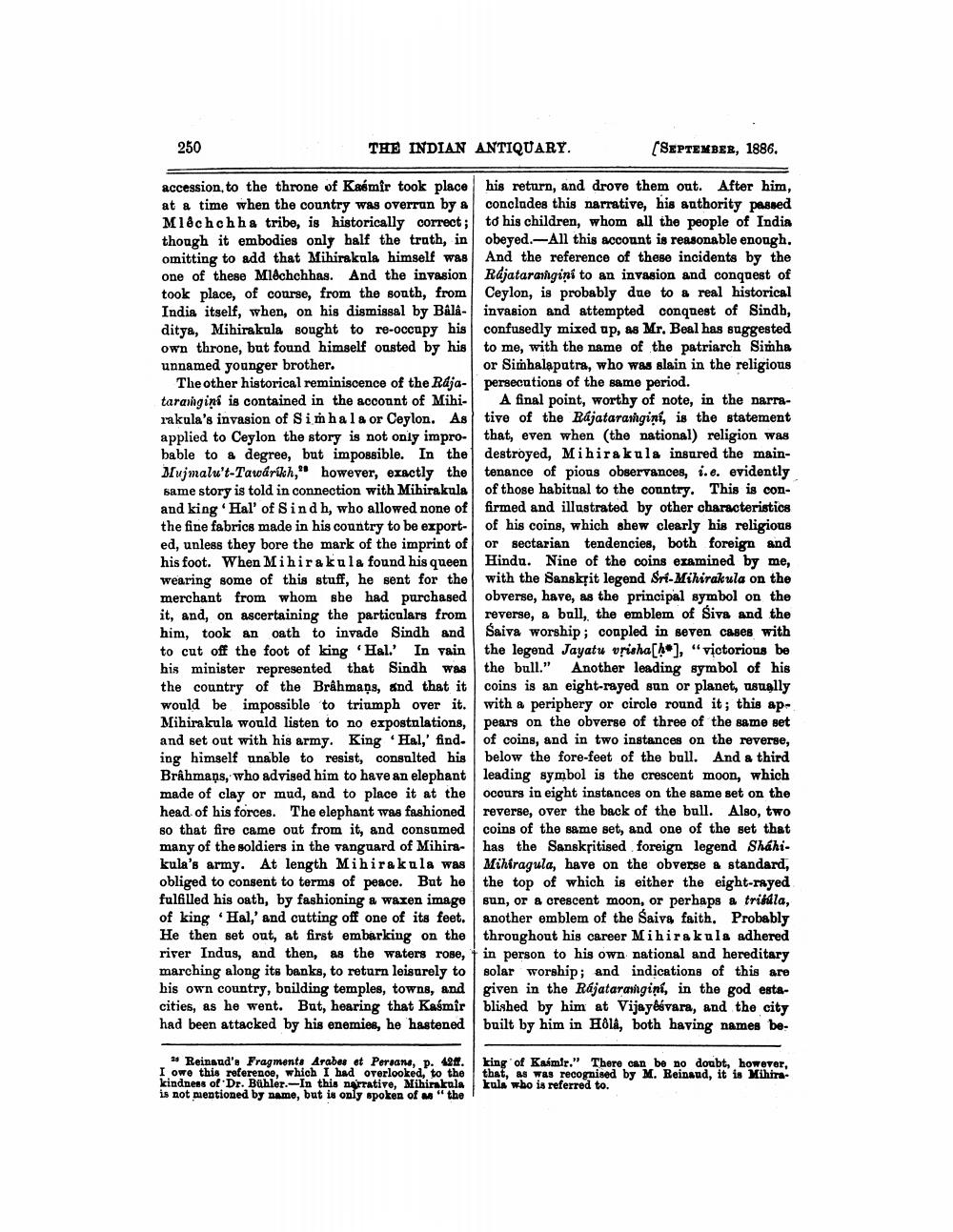________________
250
THE INDIAN ANTIQUARY.
(SEPTEMBER, 1886.
accession, to the throne of Kasmir took place his return, and drove them out. After him, at a time when the country was overrun by a concludes this narrative, his authority passed Mléchchha tribe, is historically correct; to his children, whom all the people of India though it embodies only half the trath, in obeyed.-All this account is reasonable enough. omitting to add that Mihirakula himself was And the reference of these incidents by the one of these Mléchehbas. And the invasion Rdjatarangini to an invasion and conquest of took place, of course, from the south, from Ceylon, is probably due to a real historical India itself, when, on his dismissal by Bála- invasion and attempted conquest of Sindh, ditya, Mihirakula sought to re-occupy his confusedly mixed ap, as Mr. Beal has suggested own throne, but found himself ousted by his to me, with the name of the patriarch Simha unnamed younger brother.
or Simhalapatra, who was slain in the religious The other historical reminiscence of the Raja- persecutions of the same period. tarangini is contained in the account of Mihi- A final point, worthy of note, in the narrarakula's invasion of Sinhala or Ceylon. As tive of the Rájatarangini, is the statement applied to Ceylon the story is not only impro- that, even when the national) religion was bable to a degree, but impossible. In the destroyed, Mihirakula insured the mainMujmalu't-Tawdrikh, however, exactly the tenance of pious observances, i.e. evidently
same story is told in connection with Mihirakula of those habitual to the country. This is conand king Hal' of Sindh, who allowed none of firmed and illustrated by other characteristics the fine fabrics made in his country to be export- of his coins, which shew clearly his religious ed, unless they bore the mark of the imprint of or sectarian tendencies, both foreign and his foot. When Mihirakula found his queen Hindu. Nine of the coins examined by me, wearing some of this stuff, he sent for the with the Sanskrit legend Sri-Mihirakula on the merchant from whom she had purchased obverse, have, as the principal symbol on the it, and, on ascertaining the particulars from reverse, a ball, the emblem of Siva and the him, took an oath to invade Sindh and Saiva worship; coupled in seven cases with to cut off the foot of king Hal.' In vain the legend Jayatu vrisha[ho], "victorious be his minister represented that Sindh was the bull." Another leading symbol of his the country of the Brahmaps, and that it coins is an eight-rayed sun or planet, usually would be impossible to triumph over it. with a periphery or circle round it; this apMihirakula would listen to no expostulations, pears on the obverse of three of the same set and set out with his army. King Hal,' find. of coins, and in two instances on the reverse, ing himself unable to resist, consulted his below the fore-feet of the bull. And a third Brahmaņs, who advised him to have an elephant leading symbol is the crescent moon, which made of clay or mud, and to place it at the ocours in eight instances on the same set on the head of his forces. The elephant was fashioned reverse, over the back of the bull. Also, two so that fire came out from it, and consumed coins of the same set, and one of the set that many of the soldiers in the vanguard of Mihira- has the Sanskritised foreign legend Shahi. kula's army. At length Mihira kula was Mihiragula, have on the obverse a standard, obliged to consent to terms of peace. But he the top of which is either the eight-rayed fulfilled his oath, by fashioning a waxen image sun, or a crescent moon, or perhaps a tribila, of king Hal,' and cutting off one of its feet. another emblem of the Saiva faith, Probably He then set out, at first embarking on the throughout his career Mihirakula adhered river Indus, and then, as the waters rose, f in person to his own national and hereditary marching along its banks, to return leisurely to solar worship; and indications of this are his own country, building temples, towns, and given in the Rájatarangini, in the god estacities, as he went. But, hearing that Kasmir blished by him at Vijayésvara, and the city had been attacked by his enemies, he hastened built by him in Holâ, both having names be
* Reinaud's Fragments Arabes et Persans, p. 424. I owe this referende, which I had overlooked, to the kindness of Dr. Bühler.-In this narrative, Mihirakula is not mentioned by name, but is only spoken of "the
king of Kasmir." There can be no doubt, however, that, as was recognised by M. Reinaud, it is thirdkula who is referred to.




